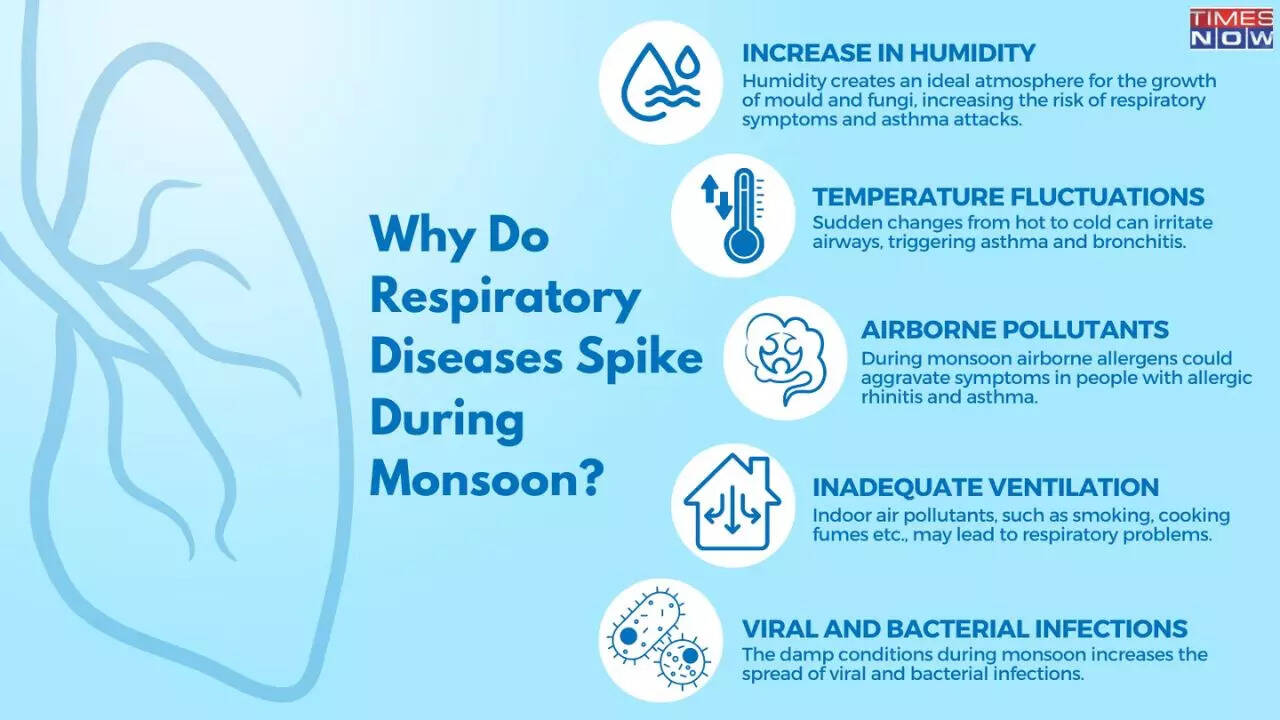Explanation: Why do respiratory diseases increase during monsoon?
The monsoon season might have given us some respite from the scorching heat, but it has also brought with it a number of respiratory problems. During monsoon, respiratory illnesses increase due to increased humidity, fungus growth and allergens in the air. So, we got in touch with a health expert to give you some tips to keep yourself safe.

Explanation: Why do respiratory diseases increase during monsoon? (Image courtesy: iStock)
Respiratory illnesses are on the rise due to excessive rains in various parts of Delhi-NCR. Although monsoon brings respite from the scorching heat, it also poses several health risks, especially for the respiratory system. Respiratory illnesses increase due to the increase in allergens, fluctuating temperatures and high humidity. So how should you protect yourself?
We caught up with Dr Kuldeep Kumar Grover, Head of Critical Care and Pulmonology, CK Birla Hospital, Gurgaon, who spoke about common respiratory problems, their causes, symptoms, and prevention and management strategies to minimise the health risks from respiratory illnesses. rainy season,
Causes of respiratory problems Monsoon
Dr. Kuldeep Kumar Grover explains that the following are the main causes of respiratory problems during monsoon:
1. Increase in humidity: Humidity levels increase significantly during the monsoon season, creating an ideal environment for mold and mildew to grow. These microorganisms release spores into the air, which can lead to respiratory problems when inhaled, especially in individuals with asthma or allergies. A study published in the Journal of Asthma suggests that exposure to mold indoors can increase the risk of respiratory symptoms and asthma attacks by up to 30 percent in sensitive individuals.
2. Fluctuations in temperature: Sudden changes from hot to cold can irritate the airways, leading to illnesses like asthma and the flu. bronchitisA study published in the European Respiratory Journal found that changes in temperature increased the number of respiratory hospitalisations by 15 per cent, highlighting the impact of temperature fluctuations on respiratory health.
3. Airborne pollutants: The pollutants trapped in the atmosphere due to heavy rainfall can cause respiratory tract irritation. Wet environments promote the growth of plants, which release pollen into the air. Wind and rain can stir up dust and other particles, triggering allergic reactions. A study in the International Archives of Allergy and Immunology highlighted that monsoon-induced changes in airborne allergens can aggravate symptoms in individuals with allergic rhinitis and asthma.
4. Inadequate ventilation: Closing windows and doors to block out rain can worsen indoor air quality, which can worsen respiratory problems. During monsoons, people tend to stay indoors, which leads to poor ventilation. This can lead to indoor air pollutants, such as smoke from smoking and cooking, which can lead to respiratory problems. Moisture-laden air can carry pollutants more effectively, leading to poor air quality. The journal Environmental Health Perspectives shows that indoor air pollution is a significant risk factor for respiratory diseases, especially in urban areas with high population densities.
5. Viral and bacterial infections: The humid conditions of monsoon favor the spread of viral and bacterial infections. Respiratory syncytial virus (RSV) and influenza are common during this season, causing respiratory tract infections. According to a report by the World Health Organization, the prevalence of respiratory infections increases during the rainy season, especially in tropical and subtropical regions.

Common Respiratory Illnesses in Monsoon
Dr. Kuldeep Kumar Grover shares his opinion Respiratory Illnesses During Monsoon Involved:
1. Asthma: Asthma attacks characterized by wheezing, shortness of breath and coughing can be triggered by allergens and humidity.
2. Allergic rhinitis: Also called hay fever, this disease is caused by exposure to an allergen and manifests as sneezing, runny nose, and itchy eyes.
3. Bronchitis: Inflammation of the bronchial tubes causes mucus formation and chronic cough.
4. Pneumonia: An illness that causes fever, chills, and trouble breathing due to inflammation of the air sacs in one or both lungs.
5. Sinusitis: Inflammation of the sinuses can cause headache, facial pain and nasal congestion.
Symptoms to note
Dr Kuldeep Kumar Grover explains that people need to be extra cautious to keep themselves safe during monsoon. Here are some symptoms to look out for.
– persistent cough
– Wheezing and shortness of breath
– Nasal congestion and runny nose
– Itching or watery eyes
– Chest pain and discomfort
– Fever and chills (in case of infection)
Tips to prevent respiratory problems Diseases that occur during monsoon
Although respiratory illnesses increase during the monsoon, there are certain preventive measures you can take to keep yourself safe:
1. Maintain hygiene: Regularly clean and disinfect your home to reduce fungus and dust mites.
2. Use an air purifier: These can reduce allergens and pollution indoors.
3. Stay hydrated: Drink plenty of water to keep your respiratory passages moist.
4. Strengthen the immune system: Eat foods rich in antioxidants and vitamin C to strengthen your immune system.
5. Avoid sudden temperature changes: Try to stay in areas with stable temperatures.
Tips to Manage Respiratory Problems During Monsoon
Respiratory problems that occur during monsoon can be managed effectively with preventive measures and timely intervention. Dr Kuldeep shares some management tips which include:
1. Medication: Take your medications as directed to treat any underlying respiratory problem.
2. Steam inhalation: This method relaxes irritated airways and reduces congestion.
3. Avoid allergies: On days when pollen counts are high, keep the windows closed and stay indoors.
4. Humidifiers and dehumidifiers: Use these to maintain indoor humidity levels at ideal levels.
5. Talk to a doctor: Seek medical help if symptoms worsen or persist.
Get the latest news on Times Now as well as breaking news and top headlines from across health and the world.


